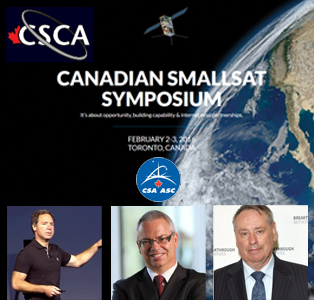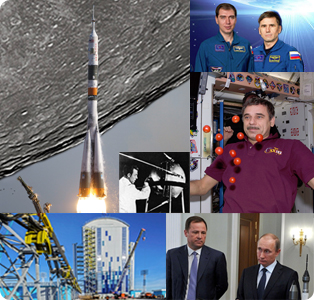Canada SmallSat Symposium: Building Capabilities & International Partnerships
The Canadian Space Commerce Association is hosting its first Canadian SmallSat Symposium at the Novotel Toronto Centre in Ontario, Canada on February 2-3. The Symposium is expected to host more than 200 people from industry, government, universities, the investment community and others interested in this growing segment of space activity. It includes two Luncheon Keynotes featuring S. Pete Worden (R) former NASA Ames Director and Lunar-exploration advocate on Breakthrough Technologies and Sylvain Laporte (C), President of Canadian Space Agency, as well as 6 Plenary Sessions, 8 Panel Discussion, up to 48 individual talks in the technical sessions, networking opportunities and a Student Mini-Symposium. Plenary speakers include Greg Wyler (L), co-founder of OneWeb, which recently attracted US$500 million in funding to deploy a SmallSat constellation to provide affordable high-speed internet connectivity around the world and Wade Larson of UrtheCast, a Canadian company offering live, high definition video from the ISS. Among other notable enterprises from Canada represented at the Symposium are NorthStar Space Data Inc., an emerging company developing its own satellite constellation to supply unique entire Earth and near-Earth space environment data to multiple markets and Canadensys Aerospace Corporation, a space systems and services company focused on accessible space, including with micro and nano space technology, currently working with ILOA on development of the International Lunar Observatory. (Image Credit: CSCA, MSU, NASA) Background Image: Lunar IceCube, Morehead State University & NASA
|
MONDAY
|

![]() = All times
= All times
for terrestrial events in local time unless noted.
![]() = All times for international terrestrial events in local time unless noted.
= All times for international terrestrial events in local time unless noted.
![]() = All times for space events, and…
= All times for space events, and…
![]() = All times for international space / astro events in Hawaii Standard Time unless noted. Add 10 hours to obtain UT (‘Universal Time;’ Greenwich, England).
= All times for international space / astro events in Hawaii Standard Time unless noted. Add 10 hours to obtain UT (‘Universal Time;’ Greenwich, England).
Weekly Planet Watch – Evening Planets: Jupiter (E), Uranus (SW), Neptune (W); Morning Planets: Mercury (SE), Venus (SE), Mars (S), Saturn (SE).
Russia Attempt to Rekindle Space Legacy Delayed Further
|
|
Continued from…
![]() Aug 28 – Aug 28, 2016 — NASA, University of Hawai`i at Mānoa, Mauna Loa HI: Hawaii Space Exploration Analog and Simulation (HI-SEAS) Mission 4; at 2,440-meter altitude.
Aug 28 – Aug 28, 2016 — NASA, University of Hawai`i at Mānoa, Mauna Loa HI: Hawaii Space Exploration Analog and Simulation (HI-SEAS) Mission 4; at 2,440-meter altitude.
![]() Jan 23 – Feb 6 — Mars Society, Mars Desert Research Station (MDRS), Hanksville UT: Crew 162 to participate in two‐week mission to simulate deep‐space exploration and study
Jan 23 – Feb 6 — Mars Society, Mars Desert Research Station (MDRS), Hanksville UT: Crew 162 to participate in two‐week mission to simulate deep‐space exploration and study
planetary research topics.
![]() Jan 25 – Feb 24 — Johnson Space Center, NASA, Houston TX: 2016 Human Exploration Research Analog (HERA) Campaign; 4 volunteers to spend 30 days in HERA 148-cubic-meter capsule simulating a mission to asteroid.
Jan 25 – Feb 24 — Johnson Space Center, NASA, Houston TX: 2016 Human Exploration Research Analog (HERA) Campaign; 4 volunteers to spend 30 days in HERA 148-cubic-meter capsule simulating a mission to asteroid.
TUESDAY
![]() Feb 2 — SETI Institute, Mountain View CA: Lecture: Exoplanet Spectroscopy with Diffraction Primary Objective Telescopy; Tom Ditto of NASA Advanced Innovative Concepts.
Feb 2 — SETI Institute, Mountain View CA: Lecture: Exoplanet Spectroscopy with Diffraction Primary Objective Telescopy; Tom Ditto of NASA Advanced Innovative Concepts.
![]() Feb 2-3 — Canadian Space Commerce Association, Toronto, Ontario, Canada: Canadian SmallSat Symposium; featuring 2 lunch keynote speakers, 6 plenary speakers, 8 panels, 48 paper talks.
Feb 2-3 — Canadian Space Commerce Association, Toronto, Ontario, Canada: Canadian SmallSat Symposium; featuring 2 lunch keynote speakers, 6 plenary speakers, 8 panels, 48 paper talks.
![]() Feb 2-3 — FAA Office of Commercial Space Transportation, Washington DC: 19th Annual FAA Commercial Space Transportation Conference.
Feb 2-3 — FAA Office of Commercial Space Transportation, Washington DC: 19th Annual FAA Commercial Space Transportation Conference.
![]() Feb 2-4 — NASA Office of Planetary Protection, KSC FL: Course: Planetary Protection: Policies and Practices.
Feb 2-4 — NASA Office of Planetary Protection, KSC FL: Course: Planetary Protection: Policies and Practices.
![]() Feb 2-4 — ESA, European Organisation for the Exploitation of Meteorological Satellites (EUMETSAT), Noordwijk, The Netherlands: Scatterometer Science Conference 2016: New challenges and opportunities.
Feb 2-4 — ESA, European Organisation for the Exploitation of Meteorological Satellites (EUMETSAT), Noordwijk, The Netherlands: Scatterometer Science Conference 2016: New challenges and opportunities.
![]() Feb 2-5 — Laboratory For Atmospheric and Space Physics, NASA, Boulder CO: MAVEN Science Team Meeting.
Feb 2-5 — Laboratory For Atmospheric and Space Physics, NASA, Boulder CO: MAVEN Science Team Meeting.
WEDNESDAY
![]() Feb 3 — ISS, Russia EVA, LEO: Expedition 46 Cosmonauts Sergey Volkov and Yuri Malenchenko to spend 5.5 hours installing hardware and science experiments on Russia segment of ISS, live coverage available.
Feb 3 — ISS, Russia EVA, LEO: Expedition 46 Cosmonauts Sergey Volkov and Yuri Malenchenko to spend 5.5 hours installing hardware and science experiments on Russia segment of ISS, live coverage available.
![]() Feb 3 — Cassini OTM-440, Saturn Orbit: Spacecraft conducts Orbital Trim Maneuver #440 today.
Feb 3 — Cassini OTM-440, Saturn Orbit: Spacecraft conducts Orbital Trim Maneuver #440 today.
![]() Feb 3 — United Launch Alliance, Launch Atlas 5 / GPS 2F-12, Cape Canaveral AFS FL: ULA Atlas 5 rocket, designated AV-057, to launch U.S. Air Force’s 12th Block 2F navigation satellite for the Global Positioning System.
Feb 3 — United Launch Alliance, Launch Atlas 5 / GPS 2F-12, Cape Canaveral AFS FL: ULA Atlas 5 rocket, designated AV-057, to launch U.S. Air Force’s 12th Block 2F navigation satellite for the Global Positioning System.
![]() Feb 3 — Luna 9 First Moon Soft Landing 50th Observation, Worldwide: As International public and private groups are developing spacecraft & rockets to reach the Moon, events Worldwide observe the 50th observation of Luna 9 (U.S.S.R) the first craft to soft land on Moon & transmit photographic data from its surface; China Chang’e-3 is most recent craft to soft land Dec 2013.
Feb 3 — Luna 9 First Moon Soft Landing 50th Observation, Worldwide: As International public and private groups are developing spacecraft & rockets to reach the Moon, events Worldwide observe the 50th observation of Luna 9 (U.S.S.R) the first craft to soft land on Moon & transmit photographic data from its surface; China Chang’e-3 is most recent craft to soft land Dec 2013.
![]() Feb 3 — Royal Aeronautical Society, London, United Kingdom: Spaceport UK: A New Frontier for Growth & Enterprise.
Feb 3 — Royal Aeronautical Society, London, United Kingdom: Spaceport UK: A New Frontier for Growth & Enterprise.
![]() Feb 3 — Goddard Space Flight Center, NASA, Greenbelt MD: Colloquium: The Science of Interstellar – Thoughts on the Habitability of Planets Orbiting Black Holes; by Dr. Jeremy Schnittman.
Feb 3 — Goddard Space Flight Center, NASA, Greenbelt MD: Colloquium: The Science of Interstellar – Thoughts on the Habitability of Planets Orbiting Black Holes; by Dr. Jeremy Schnittman.
![]() Feb 3 — Foothill College, Los Altos CA: Lecture: Innumerable Globes Like This One: Searching for Life Beyond Our Solar System; Dr. Tori Hoehler of NASA Ames.
Feb 3 — Foothill College, Los Altos CA: Lecture: Innumerable Globes Like This One: Searching for Life Beyond Our Solar System; Dr. Tori Hoehler of NASA Ames.
![]() Feb 3 — The National Academies, Online / Washington DC: Teleconference: Review of Progress Toward the Decadal Survey Vision in New Worlds, New Horizons in Astronomy and Astrophysics.
Feb 3 — The National Academies, Online / Washington DC: Teleconference: Review of Progress Toward the Decadal Survey Vision in New Worlds, New Horizons in Astronomy and Astrophysics.
![]() Feb 3 — Moon: 9.6° N of Antares, 01:00; 3.5° N of Saturn, 09:00.
Feb 3 — Moon: 9.6° N of Antares, 01:00; 3.5° N of Saturn, 09:00.
THURSDAY
![]() Feb 4 — W. M. Keck Observatory, Honoka’a HI: Astronomy Talk: How Keck Observatory Helps Decode the Formation of our Solar System; by Greg Laughlin at Honoka’a People’s Theater, 19:00.
Feb 4 — W. M. Keck Observatory, Honoka’a HI: Astronomy Talk: How Keck Observatory Helps Decode the Formation of our Solar System; by Greg Laughlin at Honoka’a People’s Theater, 19:00.
FRIDAY
![]() Feb 5-10 — American Astronautical Society – Rocky Mountain Section, Denver CO: 39th Annual Guidance, Navigation and Control Conference.
Feb 5-10 — American Astronautical Society – Rocky Mountain Section, Denver CO: 39th Annual Guidance, Navigation and Control Conference.
![]() Feb 5 — Moon: 3.2° N of Pluto, 20:00; 4.3° N of Venus, 21:00.
Feb 5 — Moon: 3.2° N of Pluto, 20:00; 4.3° N of Venus, 21:00.
![]() Feb 5 — Venus: 1.1° S of Pluto, 14:00.
Feb 5 — Venus: 1.1° S of Pluto, 14:00.
SATURDAY
![]() Feb 6-7 — SpaceUp, International Space University, ESA, Aalto University School of Electrical Engineering, Turku Science Park, Tekes, Helsinki, Finland: SpaceUp Finland.
Feb 6-7 — SpaceUp, International Space University, ESA, Aalto University School of Electrical Engineering, Turku Science Park, Tekes, Helsinki, Finland: SpaceUp Finland.
![]() Feb 6 — Moon: 3.8° N of Mercury, 06:00; 0.61° S of asteroid 18 Melpomene, 15:00.
Feb 6 — Moon: 3.8° N of Mercury, 06:00; 0.61° S of asteroid 18 Melpomene, 15:00.
![]() Feb 6 — Apollo Asteroid 2015 BN509: Near-Earth flyby (0.096 AU).
Feb 6 — Apollo Asteroid 2015 BN509: Near-Earth flyby (0.096 AU).
SUNDAY
![]() Feb 7 — RSA, Launch Soyuz / Glonass M, Plesetsk Cosmodrome, Russia: RSA Soyuz to launch Glonass M navigation satellite.
Feb 7 — RSA, Launch Soyuz / Glonass M, Plesetsk Cosmodrome, Russia: RSA Soyuz to launch Glonass M navigation satellite.
![]() Feb 7-12 — Aspen Center for Physics, Aspen CO: Conference: Dynamics and Accretion at the Galactic Center.
Feb 7-12 — Aspen Center for Physics, Aspen CO: Conference: Dynamics and Accretion at the Galactic Center.
![]() Feb 7 — Apollo Asteroid 2015 XA379: Near-Earth flyby (0.021 AU).
Feb 7 — Apollo Asteroid 2015 XA379: Near-Earth flyby (0.021 AU).
![]() Feb 7 — Apollo Asteroid 2013 VA10: Near-Earth flyby (0.022 AU).
Feb 7 — Apollo Asteroid 2013 VA10: Near-Earth flyby (0.022 AU).
![]() Feb 7 — Apollo Asteroid 2016 BQ: Near-Earth flyby (0.029 AU).
Feb 7 — Apollo Asteroid 2016 BQ: Near-Earth flyby (0.029 AU).
![]() Feb 7 — Aten Asteroid 2014 QD364: Near-Earth flyby (0.036 AU).
Feb 7 — Aten Asteroid 2014 QD364: Near-Earth flyby (0.036 AU).

